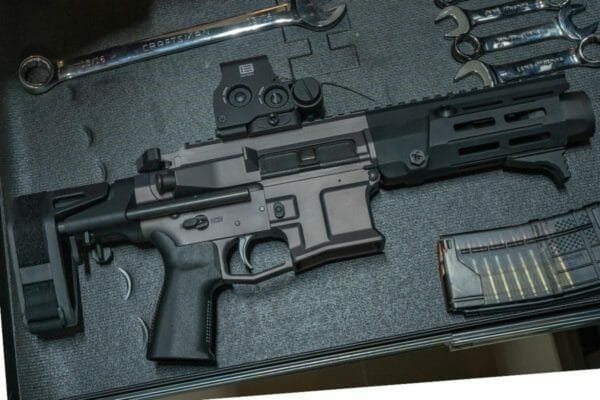
A federal judge in Texas has issued a new preliminary injunction for Firearms Policy Coalition (FPC) members and Maxim Defense against the Bureau of Alcohol, Tobacco, Firearms and Explosives (ATF) Final Rule (Final Rule 2021R-08F) on pistol stabilizing devices.
The case, Mock v. Garland, challenged the ATF’s ban on pistols equipped with stabilizing braces. FPC brought the suit in the Northern District of Texas. It was assigned to Judge Reed O’Connor, who has a stellar record on gun rights. This case would be no different.
FPC members, along with Gun Owners of America (GOA) and the Second Amendment Foundation (SAF), already have preliminary injunctions against the ATF from enforcing the rule. In this injunction, the Judge takes a shot at constructive intent, the National Firearms Act (NFA), and the other issues already cited by the courts.
In order to attain a preliminary injunction, a plaintiff must show a likelihood to succeed on the merits of the case. Judge O’Connor believes the ATF rule most likely violated the Administrative Procedures Act (APA). The final rule was vastly different from the proposed rule. The proposed rule had a worksheet (ATF Worksheet 49999) to figure out if a brace could be used on a pistol. When the rule was revealed, the worksheet was missing. Instead, the ATF issued a blanket ban covering all commercially available braces. The Judge wrote:
“The ATF’s own regulatory analysis concludes that the Final Rule has effectively reclassified 99% of all pistols with stabilizing braces to NFA rifles. Through seminal Final Rule adjudications, the ATF has already reclassified a whole host of specific weapons platforms and commercially available braced firearms to NFA rifles. Upon review of this record in conjunction with Plaintiffs’ declarations, there is no doubt that the Final Rule will subject both FPC members to criminal liability for currently possessing each of their braced pistols. The moment the Fifth Circuit’s injunction dissolves, Mock and Lewis will become felons because their braced pistols have become unregistered SBRs under the Final Rule’s reinterpretation of the NFA.”
The Judge also said the plaintiffs would suffer irreparable harm if an injunction were not issued. Judge O’Connor points out that depriving someone of a constitutionally protected right is always irreparable harm.
The Judge believes that the rule might violate the Second Amendment. He states that braced pistols are in common use and protected by the Supreme Court decisions in the Heller and Bruen cases. The government tried to argue that braced pistols are “dangerous and unusual.” Heller has an exception for dangerous and unusual weapons. The Judge wrote:
“A weapon is in ‘common use’ rather than ‘dangerous and unusual’ if it is ‘commonly possessed by law-abiding citizens for lawful purposes today.’ (holding that the Second Amendment guarantees the right possess and carry weapons ‘typically possessed by law-abiding citizens for lawful purposes’). The relevant inquiry under this standard is the current total number of a particular weapon that is in lawful possession, ownership, and circulation throughout the United States.”
Judge O’Connor also believes that without an injunction, Maxim Defense would suffer irreparable harm. The company would cease to exist without the pistol-stabilizing braces they sell. Anytime someone cannot be “made whole” by monetary means, the Court will rule they suffer from “irreparable harm.”
The Judge also found that the balance of public interest favors the plaintiffs. Judge O’Connor said that public interest can never favor an unlawful action of an agency. Judge O’Connor is implying that the ATF’s action is unlawful. The Judge is calling out the ATF in the strongest sense possible.
The Judge also took a shot at constructive intent. Constructive intent is when you do not process something but have everything you need to make it. In this case, having a pistol without a brace and a brace nearby would make it a short-barreled rifle (SBR) in the eyes of the ATF. We have seen the ATF prosecute people for having parts to make a machine gun and also take action against people with precursor parts to a suppressor.
“But even despite laying out these alternative directives for firearm owners, the ATF shortly thereafter explained that it is still entirely plausible for none of these measures to suffice for compliance. To illustrate, the Final Rule specifies that a firearm owner can still be criminally charged under the NFA for constructively possessing an unregistered SBR if their pistol could be combined with any number of objects that the ATF believes are demonstrative of a firearm’s design for shoulder fire. The set of subjective criteria the ATF lists for potential constructive possession of an NFA rifle comprises open-ended, broadly articulated standards that are left largely undefined or underdeterminate. The ATF has a decades-long history of pressing regulatory enforcement actions based on its own constructive possession theories in other NFA contexts, where the mere ease of creation of a subject firearm has been sufficient to support criminal liability for firearm owners under the NFA.”
Judge O’Connor also seems to take issue with the NFA by calling pistol braces “safety devices.” He also cites the colonists being able to modify their guns to fight the British.
“Analogous to the role that stabilizing braces play for contemporary pistol owners, Founding Era gunsmithing involved modifying lawfully bearable pistols with extended grips and rearward stocks to facilitate greater stability, control, and accuracy in single-handed self-defense fire. The Court is persuaded upon this record that the Second Amendment’s text and history ‘presumptively guarantees’ Plaintiffs Mock and Lewis the right to modify lawfully bearable pistol arms with rearward stabilizing braces for the purpose of improving the performance attributes necessary to successful armed self-defense.”
The Judge enjoined the ATF from taking regulatory action against all FPC members, the named plaintiffs in the case, Maxim Defense, and customers of the pistol brace maker. The ATF will appeal the Judge’s decision. Considering the makeup of the Fifth Circuit Court of Appeals, the government has a tough road to climb.
New Injunction Issued Against the ATF Pistol Brace Rule | Mock v Garland 92 Order on Motion for Preliminary… by AmmoLand Shooting Sports News on Scribd
About John Crump

from https://ift.tt/5DYOGK9
via IFTTT

No comments:
Post a Comment